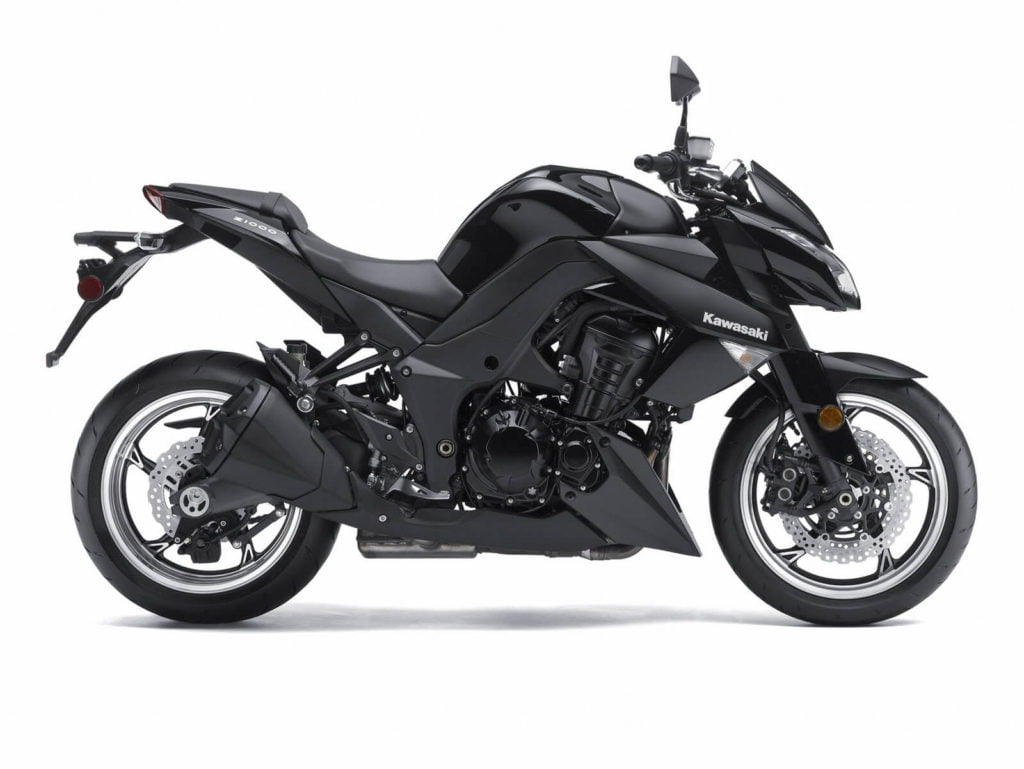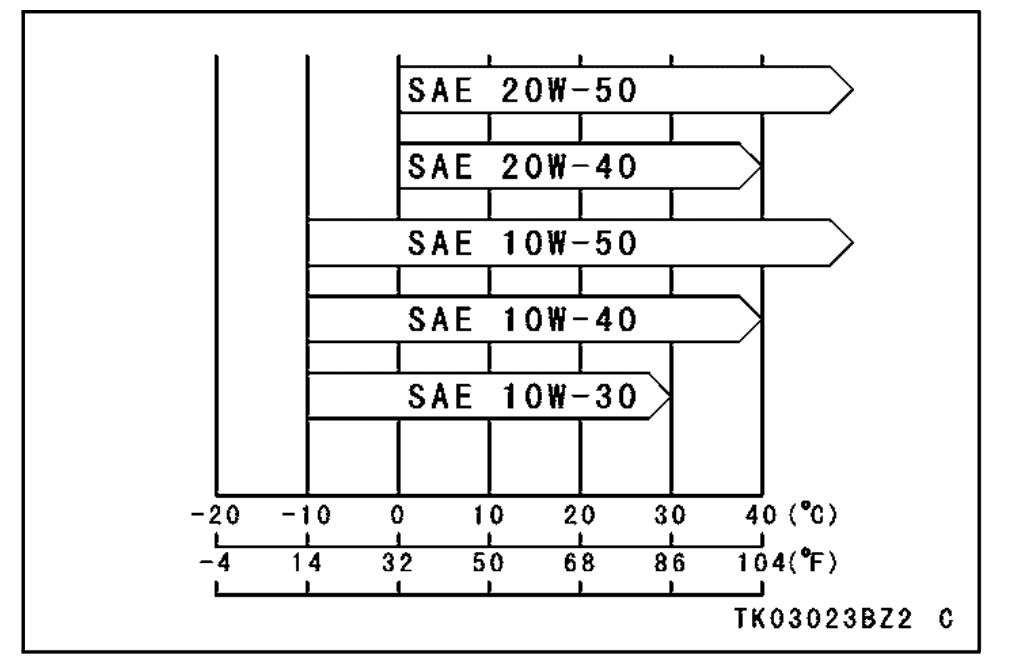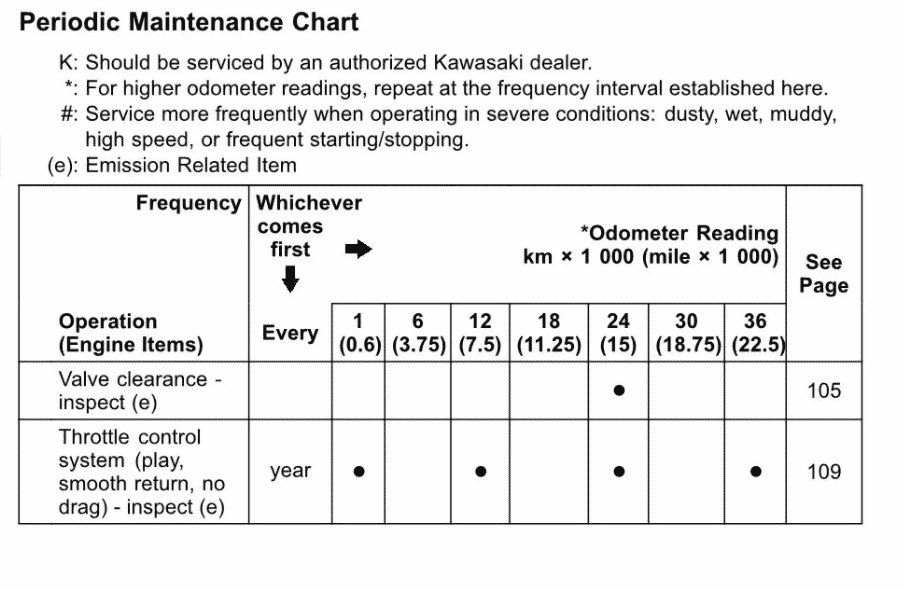2011 Kawasaki Z1000
This is the maintenance schedule with associated service intervals for the Kawasaki Z1000 Gen 3, with model years between 2010 and 2013.
The Kawasaki Z1000 is a four-cylinder sport standard first introduced in 2003. It was a "Naked" ZX-9R in 2003, and with streetfighter or standard styling. Originally, the Z1000 used a bored-out engine from the ZX-9R, but the 3rd gen Z1000 made from 2010 has a larger 1,043cc engine that's all-new and shares little to nothing with its superbike stablemate.
The 3rd gen Kawasaki Z1000 was a huge update for the Z1000. It bore very little in common with the previous Gen 2 Kawasaki Z1000, made between 2007 and 2009. Apart from the engine, the 3rd gen got fully adjustable front forks, a new die-cast welded aluminium chassis (replacing the old steel chassis), and weight that's 10kg (22 lb) lighter than the previous model — and of course, the new engine.
Kawasaki made the Gen 3 Z1000 until 2013, after which it was replaced by the Kawasaki Z1000 Gen 4.
Kawasaki also at the time sold the Z750, the smaller sibling to this generation of Z1000.

Generations of the Kawasaki Z1000
The Kawasaki Z1000 has been built in four distinct generations, with style, the engine, chassis items, and technology updating constantly.
The styling evolved with each generation, but largely they had the same streetfighter design — not trying to be retro, but just 100% a fast-looking bike.
| Spec | Gen 1 Z1000 | Gen 2 Z1000 | Gen 3 Z1000 | Gen 4 Z1000 |
|---|---|---|---|---|
| Years | 2003-2006 | 2007-2009 | 2010-2013 | 2014+ |
| Engine | 953cc (Based on ZX-9R) | 953cc (Based on ZX-9R) | 1,043cc (all new) | 1,043cc |
| Suspension | 41mm inverted cartridge, rebound & preload-adjustable | 41mm inverted cartridge, preload & rebound-adjustable | 41mm inverted cartridge, fully adjustable | Showa 41mm SFF-BP, fully adjustable |
| Front brakes | 300mm discs, 4-piston calipers | 300mm petal-style rotors, 4-piston radial calipers | 300mm petal-style rotors, 4-piston radial calipers | 310mm petal-style, 4-piston monoblock |
Since 2014, the Z1000 has continued to evolve in that Kawasaki has made constant refinements to fuelling, suspension, and safety equipment, adding things along the way like an IMU with cornering ABS in 2017.
What you need to service the Kawasaki Z1000
Being a naked roadster, servicing the Gen 3 Kawasaki Z1000 isn't as intimidating as on a bike where you have to pull off all the bodywork.
Apart from basic motorcycle maintenance tools, here's what you need to service the Kawasaki Z1000 3rd gen.
| Part | Kawasaki Z1000 Gen 3 Spec |
|---|---|
| Oil | You need 4.0L (4.2 US qt) of SAE 10W-40 engine oil "with API SG, SH, SJ, SL or SM with JASO MA, MA1 or MA2 rating", e.g. Kawasaki 10W-40 Engine Oil or a high-spec oil like Motul 7100. Don't over-torque the drain bolt (spec is 29 Nm/21 lb-ft per the manual) — use a torque wrench if you don't have experience with how much torque is enough. |
| Oil filter | Oil filter is part 16097-0008, or you can use Hiflofiltro HF303. Torque for oil filter is 17 Nm (13 ft-lb) (which basically means "don't over-tighten"). |
| Front brake pads | Get double-sintered EBC brake pads for better bite and wear — code FA379HH (same all years so far). |
| Rear brake pads | Get double-sintered EBC brake pads for better bite and wear — code FA192HH (all years). |
| Spark plugs | NGK CR9EIA-9, with a spark plug gap of 0.8-0.9mm (use a spark plug gapping tool), torqued to 13 Nm or 9 ft-lb (use a torque wrench) |
| Air filter | Easiest is the drop-in replacement of the K&N air filter part KA-1111. |
| Cable lubricant | Remember to lubricate your clutch cable (and brake cables if you have them) with a cable lubricant. Protect All Cable Life is a good general-purpose lubricant. |
| Chain lubricant | The chain needs to be lubricated every 600 km/400 miles (or more, if it gets wet/dirty). Motul chain paste is cheap and well-loved. |
| Brake fluid | Spec is to use DOT-4 brake fluid. |
| Coolant | Use 2.9L (about 3.1 US qt) of "soft water and ethylene glycol plus corrosion and rust inhibitor chemicals for aluminum engines and radiators", e.g. Valvoline Zerex G05 |
| Grease | Use a lithium soap based grease for all the important greasing points. |
Maintenance Schedule for Kawasaki Z1000 Gen 3
Below is the maintenance schedule for the Kawasaki Z1000 Gen 3.
It's a list of maintenance jobs to be done with a time or distance interval — whichever comes earlier.
The Z1000 maintenance schedule appears ina. slightly different format in the manual It has been simplified here, with sections combined.
Notes:
- For higher odometer readings, repeat at the frequency interval established here.
- K: Kawasaki recommends an authorized dealer do these items (but you can do them yourself)
- #: Service more frequently when operating in severe conditions: dusty, wet, muddy,
high speed, or frequent starting/stopping.
Kawasaki Z1000 — Items to change/replace
Note the schedule below is every 12,000 km (7,500 miles).
| km x 1000 | 1 | 12 | 24 | 36 | 48 | ||
|---|---|---|---|---|---|---|---|
| mi x 1000 | Every | 0.6 | 7.5 | 15 | 22.5 | 30 | |
| Air cleaner element # – replace (KA-1111) | every 18000 km (11250 mile) | ||||||
| Engine oil # – change (Motul 7100) | year | • | • | • | • | • | |
| Oil filter – replace (HF303RC) | year | • | • | • | • | • | |
| K | Fuel hoses – replace | 5 years | |||||
| K | Coolant – change (Valvolene Zerex G05) | 3 years | • | ||||
| K | Radiator hoses and O-rings – replace | 3 years | • | ||||
| K | Brake hoses – replace | 4 years | • | ||||
| K | Brake fluid (front and rear) – change (Castrol DOT 4) | 2 years | • | • | |||
| K | Rubber parts of master cylinder and caliper – replace | 4 years | • | ||||
| Spark plug – replace (NGK CR9EIA-9) | • | • | • | • |
Kawasaki Z1000 Gen 3 — Engine & Chassis Maintenance
Note the schedule below is every 6,000 km (3,750 miles).
| km x 1000 | 1 | 6 | 12 | 18 | 24 | 30 | 36 | ||
|---|---|---|---|---|---|---|---|---|---|
| K | mi x 1000 | Every | 0.6 | 3.75 | 7.5 | 11.25 | 15 | 18.75 | 22.5 |
| Valve clearance – inspect | • | ||||||||
| Throttle control system (play, smooth return, no drag) – inspect | year | • | • | • | • | ||||
| Engine vacuum synchronization – inspect | • | • | • | ||||||
| Idle speed – inspect | • | • | • | • | |||||
| K | Fuel leak (fuel hose and pipe) – inspect | year | • | • | • | • | |||
| K | Fuel hoses damage – inspect | year | • | • | • | • | |||
| K | Fuel hoses installation condition – inspect | year | • | • | • | • | |||
| Coolant level – inspect | • | • | • | • | |||||
| Coolant leak – inspect | year | • | • | • | • | ||||
| Radiator hose damage – inspect | year | • | • | • | • | ||||
| Radiator hoses installation condition – inspect | year | • | • | • | • | ||||
| Evaporative emission control system – function (California model only) | • | • | • | • | • | • | • | ||
| Air suction system damage – inspect | • | • | • | ||||||
| Clutch operation (play, engagement, disengagement) – inspect | • | • | • | • | |||||
| Drive chain lubrication condition – inspect # | 600 km (400 mile) | ||||||||
| Drive chain slack – inspect # | 1000 (600 mile) | ||||||||
| Drive chain wear – inspect # | • | • | • | ||||||
| K | Drive chain guide wear – inspect | • | • | • | |||||
| Tire air pressure – inspect | year | • | • | • | |||||
| Wheels/tires damage – inspect | • | • | • | ||||||
| Tire tread wear, abnormal wear – inspect | • | • | • | ||||||
| K | Wheel bearings damage – inspect | year | • | • | • | ||||
| Brake fluid leak – inspect | year | • | • | • | • | • | • | • | |
| Brake hoses and pipe damage – inspect | year | • | • | • | • | • | • | • | |
| Brake pad wear – inspect # | • | • | • | • | • | • | |||
| Brake hose and pipe installation condition – inspect | year | • | • | • | • | • | • | • | |
| Brake fluid level – inspect | 6 months | • | • | • | • | • | • | • | |
| Brake operation (effectiveness, play, drag) – inspect | year | • | • | • | • | • | • | • | |
| Brake light switch operation – inspect | • | • | • | • | • | • | • | ||
| Front forks/rear shock absorber operation (damping and smooth stroke) – inspect | • | • | • | ||||||
| Front forks/rear shock absorber oil leak – inspect | year | • | • | • | |||||
| K | Uni-trak rocker arm – inspect | • | • | • | |||||
| K | Uni-trak tie rods operation – inspect | • | • | • | |||||
| K | Steering play – inspect | year | • | • | • | • | |||
| K | Steering stem bearings – lubricate | 2 years | • | ||||||
| Lights and switches operation – inspect | year | • | • | • | |||||
| Headlight aiming – inspect | year | • | • | • | |||||
| Side stand switch operation – inspect | year | • | • | • | |||||
| Engine stop switch operation – inspect | year | • | • | • | |||||
| K | Chassis parts – lubricate | year | • | • | • | ||||
| K | Bolts and nuts tightness – inspect | • | • | • | • |
Tyre size and tyre pressure for the Kawasaki Z1000
The Kawasaki Z1000 has tubeless tyres. The manual specifies these tyre sizes and tyre pressures as standard.
| Tyre | Size | Brand(s) | Tyre pressure |
|---|---|---|---|
| Front | 120/70 ZR17 M/C (58W) | DUNLOP D210F J PIRELLI DIABLO ROSSO K | 250 kPa/36 psi |
| Rear | 190/50 ZR17 M/C (73W) | DUNLOP D210 PIRELLI DIABLO ROSSO K | 290 kPa/42 psi |
General information about the Kawasaki Z1000
The Kawasaki Z1000 Gen 3 was the best naked sports bike to come out of Japan at the time, and helped redefine naked sport bikes as being high-end sport bikes, similar to their supersport siblings.
Kawasaki built in the Gen 3 Z1000 one of the early streetfighters — a superbike in a superbike chassis with superbike components, just without the punishing riding position.
Earlier streetfighters always tended to skimp a bit on components. You'd get a basic motor from a superbike, but always end up with a worse suspension, chassis, and brakes. Not the latest Zed (or Zee).
The third gen Z1000 has a 1043cc liquid-cooled inline-four engine with more displacement and a re-tuning that gave it ample torque all over the rev range, meaning effortless acceleration in almost any situation.
The star of the show for the Gen 3 Zed is the new motor. The new engine's bore and stroke of 77.0 x 56.0mm (with an increased displacement of 1,043cc, up from 953cc from the Gen 1-2) let engineers offer a better balance of peak power and low and mid-range flexibility that's much more suited to a naked bike.
The new engine makes 100 kW or 136 hp. The longer-stroke engine is tuned to make a lot more mid-range — so between 4,500 rpm and 10,000 rpm the power is very ingressive. It's not quite as "instant on", but a gearing change could improve that. Importantly, the power curve is incredibly linear, thanks to the very flat torque curve (that does get a little bump around 7,000 rpm).
A common complaint of earlier Gen 1 and Gen 2 Z1000 models was that the suspension was too soft and not adjustable. Kawasaki took these complains seriously for the Gen 3, and so the Gen 3 Kawasaki Z1000 has stiffer suspension that's fully adjustable for preload, rebound damping, and compression damping. Hooray!
The new Z1000 also got a new lightweight aluminum frame (replacing the old steel subframe), digital instrument panel, bodywork, and engine.
A quick word on the bodywork — the Gen 3 Z1000 was really nice to look at. It was before Kawasaki started calling their design language "Sugomi", but it already had elements of that design language in there — aggressive, powerful looking.
The Z1000's rear suspension design puts the shock unit and linkage above the swingarm, where it's less exposed to exhaust heat, and helps with mass centralisation. Seeing the horizontal monoshock helps contribute to the Z1000's overall aggressive appearance. The shock has stepless rebound damping and spring preload adjustability.
The Z1000's 300mm front petal-style brake discs are gripped by opposed four-piston radial-mount calipers. The front brakes are controlled by a radial-pump front brake master cylinder. Compared to superbikes or other high-end streetfighters, the Z1000's brakes lack bite a bit, but they're adequate for the power and weight of the bike.
Manual for the Kawasaki Z1000

The above maintenance schedule comes directly from the user's manual for the 2012-2013 Kawasaki Z1000, which is available here.
Source: https://maintenanceschedule.net/kawasaki-z1000-gen-3-maintenance/

0 Komentar